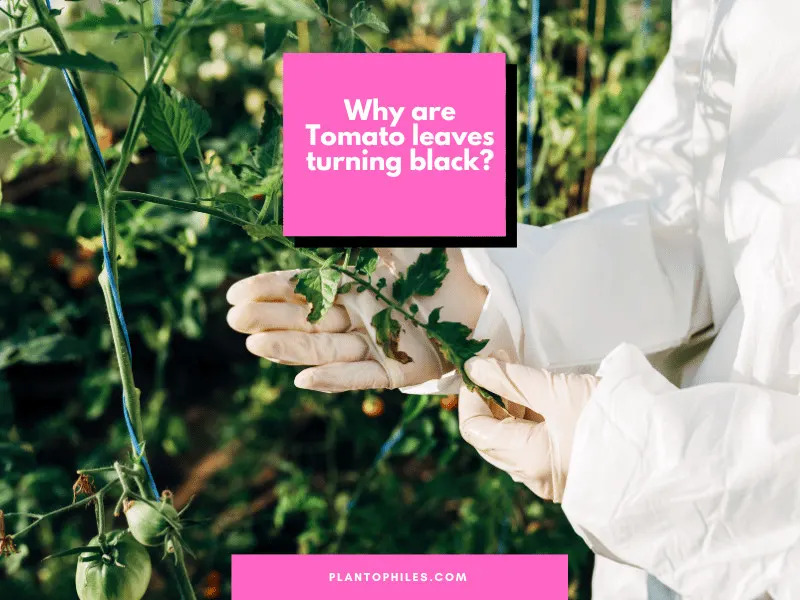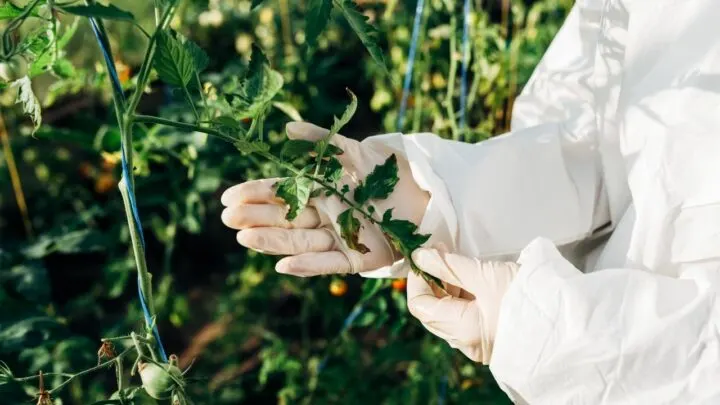Why are the leaves of tomato plants turning black? Tomatoes are very low-maintenance plants and are grown around the world.
Tomato seeds are currently being developed to be grown in space!
However, these plants don’t come without diseases and pest problems.
If you notice your tomato plant’s leaves turning black, your plant needs attending to as soon as possible.
Read on to diagnose the problem and learn how to cure it. These are the most common issues for black leaves I have identified with the tomatoes in my garden.
Table of Contents
Why are Tomato leaves turning black?
If your tomato plant has leaves turning black, they most likely have a disease such as late blight, bacterial speck, or bacterial canker. A common disease is septoria leaf spot leading to tomato leaves turning black. Diseases can be treated using chemical or natural fungicides and can be prevented by purchasing disease-resistant seeds and practicing cleanliness when handling tomato plants.

Reasons why tomato leaves turn black
Late blight
Blight is a disease that has been known to frustrate and puzzle gardeners all over the world. It spreads rapidly and can wipe out a whole field of crops in a very short amount of time.
There are two different forms of blight: late blight and early blight. Late blight displays symptoms of dark spots on the edges of your tomato plant’s leaves, whereas early blight does not.
These dark patches may even grow toward your tomato plant’s stem. Small dots of white mildew may also grow on the infected areas.
Bacterial speck
Bacterial speck is a common plant disease that occurs worldwide regardless of the environment or temperament.
Symptoms include small black spots around the surface of the leaves that are mostly more prominent on the undersides.
These spots can sometimes have a yellow ring, especially if the plants are more mature, and these spots can be raised or sunken to the touch.
Unlike most tomato plant diseases, bacterial speck also affects the tomato fruit. As the disease progresses, black spots will begin to grow on the skin of your tomatoes.
Eating fruits infected by bacterial specks can cause illness, and it is suggested that no fruit that appears to be discolored is consumed at all.
Bacterial Canker
Bacterial canker is a disease that attacks a tomato plant’s fruits, foliage, and stems.
Symptoms include discoloration of the leaves, beginning with the tips becoming brown and crispy, and as time progresses, the veins and centers of the leaves will turn a black or brown color.
The stems will also turn black if left untreated, and the tomato fruits will grow white spots.
Often it is the case that bacteria canker has come from an infected tomato seed. This disease spreads rapidly, and just one infected plant could wipe out a whole greenhouse of crops.
Unclean gardening tools or pots that have not been cleaned before use can also spread this disease.
Practicing cleanliness when handling your tomato plant to prevent infections is important.
Septoria leaf spot
Septoria leaf spot is a fungus that predominately affects the leaves of a tomato plant.
Early symptoms include yellow spots appearing on the undersides of older leaves that will eventually turn a dark blackish brown.
Another identifying feature is the spots having a light brown halo around them.
The leaves will become dry and limp from here before completely falling off.
Septoria is usually caused by your tomato plant being too moist; it may result from heavy rainfall or overwatering.
A severe bought of septoria leaf spot can leave a tomato plant unable to bear fruit, as it has become too weak and damaged.
How to treat black tomato leaves
Many fungicides on the market treat tomato leaves that are turning black, many of which specialize in treating specific diseases.
These can be purchased from garden centers and plant nurseries and must be diluted and sprayed directly onto the leaves.
If you prefer a less harsh and more natural solution, you could choose to create your fungicide.
Mix one teaspoon of baking soda with 4 cups of lukewarm water, and add a drop or two of liquid soap.
Spray the solution all over your plant and its leaves, and repeat once a week until you see signs of improvement.
Preventing tomato leaves from turning black
One way to prevent tomato leaves from turning black is to choose varieties of tomato plants created to resist disease.
For example, some tomato seed packets will state that they are blight resistant.
It is also suggested that you don’t plant your tomatoes in the same area every year, especially not when planning to use the same soil.
If you plant your tomato plants in pots, be sure to bleach the pots thoroughly after the season is over.
Diseases can harbor themselves in soil and stay dormant during winter, ready to pounce on your new crops the next season.
Some gardeners even go further to ensure their plants are protected from disease.
Washing your tomato seeds in hot water (around 120 degrees Fahrenheit) for 30 minutes before planting can kill diseases that are living on them.
Frequently Asked Questions
Should I cut the black leaves off of my tomato plant?
If only a few leaves have begun to turn black, you could cut them off to stop the rest of your leaves from being affected. If most leaves are black, avoid pruning them and try other methods.
What to do if your tomato leaves turn black?
If the cause is a fungal disease, use a fungicide to treat the black leaves on your tomato.
How to prevent getting black leaves on tomatoes?
Buy disease-resistant tomatoes and wash tomato seeds in hot water before planting.
Takeaways
Black tomato leaves mostly have a fungal or bacterial cause that can be treated using a fungicide.

Daniel has been a plant enthusiast for over 20 years. He owns hundreds of houseplants and prepares for the chili growing seasons yearly with great anticipation. His favorite plants are plant species in the Araceae family, such as Monstera, Philodendron, and Anthurium. He also loves gardening and is growing hot peppers, tomatoes, and many more vegetables.


